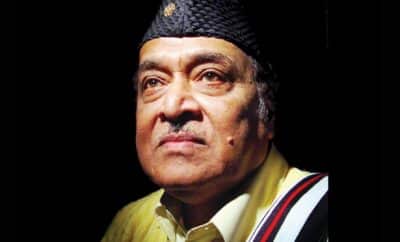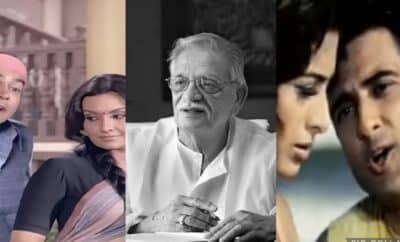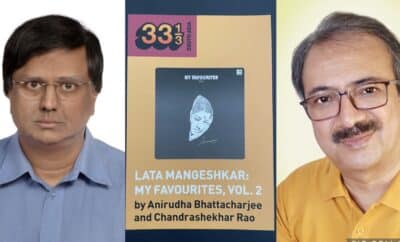Collections
R D Burman and the Stylish Sixties
1960s. A sort of renaissance for Hindi films altogether. Renovation of style in all forms. The way films were made, their storylines, the casting, acting, clothes, make up, et al. Method acting and melodramatics changed to natural and spontaneous. Simple but gorgeous chiffon sarees changed to figure hugging dresses. The formal blazers and ties changed to flashy shirts, angular caps and flowy scarves. Graceful, loose tresses changed to chic bouffants. All in all, everything around was stylish and highlighting the club culture.
The music was also changing to suit the storylines and the themes of the films. There was a shift in the established genre of classical music with much lighter forms like thumri, ghazal etc. taking its place. Even then, it was the cabarets and the club songs which dominated a good part in the 60s.
This period of Hindi film music also known as the golden period, saw the enhancement of some music composers, downfall of a few older ones and emergence of the new ones. Some were tasting the new highs, some kept the consistency intact while others were churning out what was expected of them. Amongst the doyens were Shankar Jaikishan, Naushad, S D Burman, Kalyanji Anandji, Madan Mohan, O P Nayyar. 60s saw the emergence of 2 future stalwarts in the field of music composing – Laxmikant Pyarelal and R D Burman. It was raining variety in music. Love songs, ghazals, qawwali, classicals apart from the much loved club songs and cabarets. Even if the 50s had seen the emergence of western music with C.Ramchandra bringing in the jazz element and using it extensively in his songs, it was the music from the 60s that can truly be called stylish. A congruence of sound, melody and rhythm. There are very few composers who have had all the three (sound, melody and rhythm) in their songs. R D Burman or Pancham is one such name. Pa – the eternal fifth note. For every Pancham fan it is Pa for Pancham. The note that maintains harmony and equilibrium. Pancham has always been known for his stylish ways. His shirts, his hairstyles, his moustaches (yes he had them for some time), his way of smoking, his perfumes, his car. All this stylishness reflected in his creations. The uber stylish quality of his songs remains forever young.
Coming back to discussing some of the stylish creations by him in the 60s. If we listen to his songs from the 60s carefully, we can very well see traces of his future works in those songs. A sign of a man simply ahead of his time.That phrase has become a cliche now but it is so true. Except for Teesri Manzil and Padosan, rest of his work from the 60s is either sidelined or less discussed. Here is an attempt to bring forth his stylish songs from the 60s.
Chhote Nawab – Jeenewaale
Pancham’s first film as an independent music director and he introduced a new sound. The flamenco style, the big brass, etc. Chhote Nawab had a mixed bag of songs. From Ghar aaja ghir aayi to Ilahi tu sun le, the album boasts of different genres handled precisely and delicately. The film also saw the coming together of Helen and Pancham sans Asha! It is Lata Mangeshkar who lends her voice to the gorgeous and stylish Helen in both the club songs. Of course Matwaali aankhon waale has been widely discussed now for its stylish flamenco, so lets check the other number where Helen’s accompanied by the brilliant Johnny Walker and playbacked by Lata Mangeshkar and Mohammed Rafi respectively. In between the slurry aahaa aahaa by Mehmood is typical Pancham touch. Pancham was assisted by none other than Laxmikant Pyarelal for this film. A short guitar start and Pancham heads straight for the mukhda. In come the unmistakable bongos, played by the one and only Cawas Lord! The interludes have the jazzy trumpets but the antara has a diversified pattern of rhythm on dholak and tabla and then that connecting guitar again. Talk of style and Pancham has his own. He doesn’t stop here. The second interlude has the wonderful accordions (most probably Kersi Lord) and miniscule use of guitar just before the antara begins. Towards the end we also have melodious mandolin and throughout the main song there is the elegant violin by Pyarelal, the fantastic arranger. Pancham’s only film with the genius Shailendra.
Bhoot Bangla – Aao Twist Karein
Inspired by Chubby Checker’s Come Let’s Twist Again, the song started a significant partnership between Pancham and Manna Dey who was otherwise known for graceful semi classical numbers. A song much ahead of time, brings in the flamboyant side of Manna Dey. Pancham created this marvel with a bigger orchestra. Drums played by Lesslie Gudhino, the breathtaking electric guitar by Dilip Naik. There are those high voltage trumpets. All these making the song jazzy again. The later part of the song has Saxophone by Manohari Singh. Pancham has used the double base throughout the song. The song created a storm in 1965 with its magnificence. If Pancham’s first film was with Shailendra, his second was with another legend, Hasrat Jaipuri!
Teesra Kaun – Achcha Sanam
This was coincidentally Pancham’s third film but first for the wonderful Asha – Pancham partnership and the legendary Anand Bakshi – Pancham partnership. Asha Bhosle croons for the astute Shashikala. This particular song though feels like an example of Bossa Nova, it isn’t. In the 60s the popularity of accordion and mandolin based songs was the legacy of the 50s. This song is an example of Pancham staying with the tradition and styles of those years. It is a rare example of a Pancham song with a conventional mandolin pattern. The song has a simple rhythm base of the bongos by Cawas Lord. The prelude starts with the violins and paces further with the bongos and mandolin. Backed by rhythm guitar. Pancham’s stylish and unconventional way of taking the song further. It further speeds up, full of energy but once the mukhda starts it comes back to half the speed of the rhythm with just one beat each time. The rhythm blends perfectly with violins. The interludes are again different. If the first interlude has mandolin and rhythm guitars, the second has typical Pancham flutes.
Pati Patni – Maar Daalega Dard-e-jigar
Pancham’s second film with Anand Bakshi and also Asha Bhosle. Asha Bhosle called this song as technically testing. She said in an interview, “Maar Dalega Dard-E-Jigar first made me sit up and take notice of Pancham as a composer. I came to discern that even a seasoned singer like myself had to be alert while negotiating his tunes, which are none too easy to render while being so appealing to the ear.” A fantastic creation and an enticing melody. It has the sizzling Brazilian Bossa Nova. It was Pancham who first used Bossa Nova in Hindi film music. The prelude has Wooden Claves, mallet, vibraphone, xylophone and the guitar. The song starts with the rhythm on Bongo, chords on guitar and the claves. Asha Bhosle modulates her voice beautifully in between these instruments. Enter Manohari Singh on Saxophone changing the scale of the song. Maruti Rao Keer skilfully matches it on the Bongo. A sizzling cabaret, difficult to render but sounds fresh and stylish even after over 50 years!
Teesri Manzil – O Haseena Zulfonwaali
Stylish and iconic, Teesri Manzil readily clicked with the audience. A cinema lover couldn’t ask for more with the wizard Vijay Anand directing it. With this film began another fantastic partnership between Pancham and Majrooh Sultanpuri. This gripping tale of suspense, drama with a flavor of humor and romance, is elevated several notches with its songs. With a blend of rock, jazz and Latino, it created history. The spectacular O haseena zulfon waali jaan-e-jahan….had the yin and yang of Helen and Shammi Kapoor. The song which is an epitome of stylishness! Prelude starts with Leslie Gudhino’s drums followed by violins and there’s that bold, prominent tambourine by Homi Mullan. The further ensemble of instruments include the triangle, flutes, high scale trumpets, trombones and organs. There are snare drums, very Bossa Nova pattern Saxophone by Manohari Singh, Rhythm guitar Dilip Naik, flutes and Buji Lord’s Vibraphone!!
The song wasn’t a spectacular one just on screen but it was an extravaganza behind the screen too with around 80 musicians. Teesri Manzil was a game changer. It also reinstated the fact that R D Burman was here to stay and stay long.
Baharon Ke Sapne – Do Pal Jo Teri
The trio of Pancham, Majrooh Sultanpuri and Nasir Hussain again came together for Baharon Ke Sapne and this was produced and also directed by Nasir Hussain. It was also the first coming together of Pancham and Rajesh Khanna.
This particular song, a female duet between Asha Bhosle and Usha Mangeshkar is a lesser heard and lesser discussed compared to the other songs of the film.
This song is especially for students learning the arrangement of brass.
A breathtaking 1 min 11 secs prelude full of experiments and ecstasies. Full brass especially with trumpets and trombones, electric guitar by Dilip Naik and the Vibraphone by Buji Lord is so prominent. Manohari Singh’s saxophone creates suspense.
Mood changes with the stanza starting with violins and vibraphone; the low sound violins and bongo beats reveal something which is heard in the second stanza. The early part of stanza is on a bit low scale and later as the brass gives a new start the scale changes. The style, the approach had a magnetic effect on the youth of the day. Could you find some of his future song/songs in this one?
https://youtu.be/rViBjzS89mo
Abhilasha – Pyar Hua Hai Jab Se
Abhilasha (1968) was Pancham-Majrooh’s first film together outside Nasir Hussain camp. Mostly known for its male – female tandem song Waadiyan mera daaman. The cheerful and breezy number Pyar hua hai jabse was totally wasted with bad picturisation. Prelude consists of Glockenspiel, piano and strings.
The Mukhda starts with superb drums and bongos and supplementary rhythms like shakers. Then there’s saxophone by Manohari Singh followed by violins and xylophone. The stanza although has no harmony of strings or brass, the voices of Lata Mangeshkar and Kishore Kumar enhance the supplementary rhythms and is a delight to hear. The triangle played a bit randomly sounds superb. The acoustic guitars and rhythm guitars and xylophone are played superbly and in an expressive way.
Pyar Ka Mausam – Na Ja O Mere Humdum
Majrooh and Pancham were once again roped in by Nasir Hussain for Pyar Ka Mausam (1969). Nasir Hussain stopped experimenting after the debacle of Baharon ke Sapne and brought back his formula of the lost and found story with a lot of romanticism.
This song is all about love, desperation and pleading. About beseeching with the voice echoing in the valley. And Lata Mangeshkar excels here.
Pancham has used the Tubular Bells struck by a hammer. The bells create a specific haunting effect or rather suspenseful effect.
The sign-in line has a very superb electric organ, simple rhythm on congas and bongo.
One can also hear violins and organ phrases followed by violins and cellos followed by bamboo flute and then the Electric guitar. The stanza just has the electric guitar.
Waris – Lehra Ke Aaya Hai
Just like the 80s, Pancham – Lata combination in the 60s has been amazing with all the lilting melodies. This song from Waris is one such example. A complete carefree singing by her along with Rafi. The prelude created and designed is one of its kind. The score is much like a Middle East pattern blended with concerto style. From 00 to 28 secs there’s a much complicated score with high variation in notes and gradually it is brought to the Indian light music style.
Extended prelude with vocal then the violins and later the guitar with a shrill sounding instrument vibraphone and at the end the organ. A very different style sign line much different from the lines and track of the prelude. The rhythm guitars play a lead role along.
The interlude is superb with the organs and violins and as the organ starts we hear the Bossa Nova rhythm on the Congo. As the song progresses, the rhythm gives the feel of Bossa Nova but it is not. The arrangement is a mixed bag of guitars, flute, strings and of course rhythm. The Arabian feel of the song makes it more infectious.
Though Pancham’s work from the 70s and 80s is widely discussed, music lovers are yet to discover his beauties from the 60s. Though his work with Asha Bhosle is widely discussed, his work with Lata Mangeshkar forms the backbone of his career. Taking a look at his work from the 60s, he has worked with almost all the ace singers and lyricists. Pancham created his own magic. He made songs without the fear of rules and limits. In the world full of trendy songs, his stylish songs remain timeless classics.




Ajay
June 27, 2022 at 10:59 am
Excellent writeup ! “Padosan” 1968, Missing.
Milind Pathare
June 27, 2022 at 11:03 am
Excellent take Deepa! Panchamda’s style remains inimitable & for our generation to have experienced this melody in our youth has kept the romance in our lives forever♥️
Rimi Basu Singa
June 27, 2022 at 2:00 pm
Awesome ? infos full of entertainment. ??? All the best.
Peeyush Sharma
June 29, 2022 at 9:51 pm
Very well written. Hats off to you. Do pal jo teri…. Is not discussed much, but is an amazing master piece probably singularly a lesson on how to design a club song. It also has RD vocals in the begining. Abhilasha had that superb male duet, ek janib shame mehfil. Simply a delight. The more I listen to RD the more i discover amazing experiments. He was just one and only God sent.